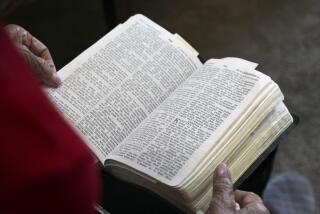Declaration’s evolution goes high tech
- Share via
WASHINGTON -- The Declaration of Independence looked a bit different before Benjamin Franklin got his hands on it, using a pen to scratch out the words “sacred and undeniable.” After all, he thought, it would be better to make these truths “self-evident” that all men are created equal.
Edits such as this are captured in a new exhibit at the Library of Congress that enables visitors to literally zoom in on the specific words and phrases that formed the basis of the American republic. They can see different versions of historic documents and examine them line by line, using interactive, touch-activated computer screens that show the library’s first high-definition scanned images of the drafts.
“It’s the first time a visitor to the exhibit can actually see the changes that were made,” curator Gerry Gawalt said. “We stress the creativity, the compromise and the cooperation that was needed to work their way through these documents and to get a successful product.”
Franklin’s hand, along with John Adams’, can be seen in the scribbled additions and crossed-out words in Thomas Jefferson’s draft of the declaration. One of Franklin’s key changes -- deleting “sacred and undeniable” -- addressed concerns that the declaration would sound too religious.
In the exhibit “Creating the United States,” visitors can also take a look at the proposed Bill of Rights and George Washington’s copy of the Constitution, which includes the first president’s notes on the debate during the Constitutional Convention.
Each document has a dedicated, interactive kiosk that enables students and researchers to closely examine the library’s treasures and to trace the origins of the country’s founding ideas. For example, they might learn that the Bill of Rights was initially created as a diversion to prevent the anti-Federalists from rehashing the entire Constitution.
The high-tech offerings are a big leap for the world’s largest library, which has sought to give visitors more ways to access its books, documents, audio and video resources. Interactive elements from the exhibit will also be available on the library’s new website.
The changes come as the library anticipates a surge in annual visitors when the underground Capitol Visitors Center opens in late 2008. The library will be connected to the visitors center by tunnel, which could double or triple the library’s 1.4 million annual visitors, according to current estimates. Officials expect visitors to meander between the buildings as they wait for a tour of the Capitol.
The library has invested $23 million -- all private funding -- to create new exhibits as part of the Library of Congress Experience, including about $3 million in software and services from Microsoft Corp.
Technical advances at the library ultimately could include posting digital copies of entire books online, including volumes from Thomas Jefferson’s collection that served as the foundation for the Library of Congress.
More to Read
Sign up for The Wild
We’ll help you find the best places to hike, bike and run, as well as the perfect silent spots for meditation and yoga.
You may occasionally receive promotional content from the Los Angeles Times.





